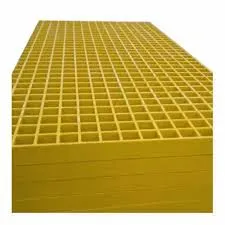loading...
- No. 9, Xingyuan South Street, Dongwaihuan Road, Zaoqiang County, Hengshui, Hebei, China
- admin@zjcomposites.com
- +86 15097380338
- Welcome to visit our website!
frp pressure vessel tank
Understanding FRP Pressure Vessel Tanks Applications and Advantages
FRP (Fiber Reinforced Polymer) pressure vessel tanks have emerged as a significant innovation in the storage and transportation of liquids and gases under pressure. The composite nature of FRP combines high-strength fibers, usually glass or carbon, with a polymer matrix, providing an exceptionally durable and lightweight solution. As industries increasingly seek materials that offer superior strength-to-weight ratios and corrosion resistance, FRP pressure vessel tanks have gained prominence in various sectors, from chemical processing to water treatment.
What is FRP?
FRP is a composite material made of a polymer matrix reinforced with fibers. The most common types of fibers used are glass fibers and carbon fibers due to their high tensile strength and lightweight properties. The polymer matrix—usually thermosetting resins like epoxy, vinyl ester, or polyester—binds the fibers, giving the composite material its shape and additional strength. When these components are combined, they create a material suitable for high-pressure applications, making FRP an ideal choice for pressure vessels.
Advantages of FRP Pressure Vessel Tanks
1. Corrosion Resistance One of the most critical advantages of FRP pressure vessel tanks is their exceptional resistance to corrosion. Unlike traditional materials like steel, which can rust and degrade when exposed to harsh chemicals and fluids, FRP tanks remain unaffected, extending their service life and reducing maintenance costs.
2. Lightweight The lightweight nature of FRP constructions is another significant benefit. FRP vessels weigh considerably less than their metal counterparts, making them easier to transport and install. This factor is particularly important in projects where weight constraints are critical.
3. High Strength-to-Weight Ratio FRP pressure vessels possess a high strength-to-weight ratio, making them capable of withstanding high pressures without thickening the walls excessively. This characteristic allows for more efficient use of space and materials.
frp pressure vessel tank

4. Customizability FRP tanks can be tailored to specific shapes and sizes, accommodating diverse applications. This adaptability makes them suitable for various industries, including wastewater treatment, chemical processing, oil and gas, and food and beverage.
5. Thermal Insulation The polymer matrix in FRP materials provides excellent thermal insulation properties. This feature is particularly valuable in applications where temperature control is necessary, reducing energy costs and improving process efficiencies.
Applications of FRP Pressure Vessel Tanks
Given their advantageous properties, FRP pressure vessel tanks are utilized in numerous applications. In the chemical industry, they are used for storing corrosive substances such as acids and alkalis safely and efficiently. In wastewater treatment, FRP tanks are employed for aeration and anaerobic digestion processes, contributing to the effective purification of water.
Moreover, in the oil and gas sector, FRP pressure vessels are used for the storage of petroleum products, where their corrosion resistance and lightweight properties significantly enhance operational safety and efficiency. Additionally, the food and beverage industry uses FRP tanks for their sanitary qualities, ensuring that food-related liquids are stored safely without contamination.
Conclusion
As industries continue to evolve, the demand for materials that not only meet high-performance standards but also offer longevity and safety is critical. FRP pressure vessel tanks stand out as a robust solution, combining corrosion resistance, lightweight properties, and high strength. Their versatility in application across different sectors demonstrates their invaluable role in modern industrial practices. Embracing FRP technology allows industries to improve safety, decrease maintenance costs, and enhance operational efficiency, solidifying the importance of FRP pressure vessel tanks in today's market.
-
The Rise of FRP Profiles: Strong, Lightweight, and Built to LastNewsJul.14,2025
-
SMC Panel Tanks: A Modern Water Storage Solution for All EnvironmentsNewsJul.14,2025
-
GRP Grating: A Modern Solution for Safe and Durable Access SystemsNewsJul.14,2025
-
Galvanized Steel Water Tanks: Durable, Reliable, and Ready for UseNewsJul.14,2025
-
FRP Mini Mesh Grating: The Safer, Smarter Flooring SolutionNewsJul.14,2025
-
Exploring FRP Vessels: Durable Solutions for Modern Fluid HandlingNewsJul.14,2025
-
GRP Structures: The Future of Lightweight, High-Performance EngineeringNewsJun.20,2025
